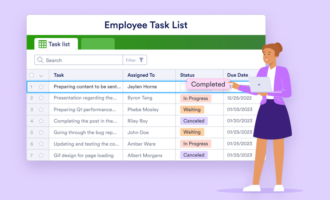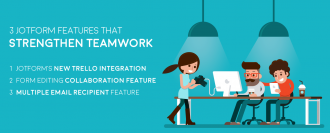10 collaboration challenges
- Poor leadership
- Miscommunication and poor flow of information
- Lack of unity around goals
- Poor engagement among team members
- Lack of collaborative infrastructure
- Collaboration overload
- Imbalanced distribution of work
- Collaborative inertia
- Distrust and disrespect
- Lack of tools
Building a collaborative workplace culture and engaging in joint work can be incredibly rewarding. But a myriad of factors can get in the way of good teamwork, so it’s important to be vigilant and guard against them.
Here are 10 common collaboration challenges that executives and employees face.
1. Poor leadership
Effective collaboration starts at the top — with senior managers and C-suite executives. If you don’t model a culture of teamwork and collaboration, how can you expect everyone else to get on board?
Some common examples of poor leadership include
- Micromanaging employees instead of inviting them to work together to create solutions
- Failing to coach employees for collaborative work and delegate effectively
- Nurturing groupthink rather than encouraging healthy debate
- Prioritizing your own ideas instead of letting the collaborative process play out
Leaders must use their authority to create an environment that empowers individuals and breaks down divisions between team members and departments.
2. Miscommunication and poor flow of information
You can’t openly share ideas, process feedback, gather input, and debate different approaches if you don’t communicate well. Misunderstandings, misinterpretations, and gaps in correspondence can put team members on different paths.
Incidentally, modern communication technologies are often part of the problem. When people communicate digitally — through email or instant messaging, for example — they can’t read body language, facial expressions, or tone of voice to assess meaning and intent.
What’s more, if someone doesn’t copy the right people on an important email or sends out the wrong version of an evolving document, colleagues will operate under different assumptions — and that will breed confusion.
3. Lack of unity around goals
A shared, common purpose with clearly defined goals motivates strong collective action. Every collaborator needs to know their role and each participant’s tasks, priorities, obstacles, expectations, and responsibilities to effectively combine forces. Otherwise, you risk developing different agendas and solving contrasting problems, which can quickly fragment a team effort.
4. Poor engagement among team members
For collaboration to be successful, all parties need to be invested in the collaborative process. They have to want to work as a team.
Many people are protective of their ideas, unwilling to relinquish control, and uncomfortable with the conflict that often comes with collective projects. We don’t like saying, “I don’t know; what do you think?” — especially members of senior management — and we often struggle to trust others to do a good job.
What’s more, some of us feel we work more effectively alone, don’t want to take responsibility for other people’s failures, or simply don’t believe in the value of a particular project as much as others do.
5. Lack of collaborative infrastructure
Physical barriers between departments can present huge hurdles for collective work. If a building doesn’t feature common areas, meeting rooms, and breakout spaces that facilitate engagement, it’s more difficult to interact.
But what if your team isn’t in the same building — or even the same state? With the rise of remote work, businesses can no longer rely solely on a well-designed office to encourage collaboration.
Technology — videoconferencing software, project management platforms, and file-sharing apps — can help bridge communication gaps both within and between departments.
6. Collaboration overload
As essential as workplace collaboration is, it can also be an incredibly time-consuming endeavor, requiring patience, effort, and energy you may not always be able to give. If your schedule is already packed, the request to assist, offer input, attend meetings, and respond to emails can quickly overwhelm you — causing collaboration overload.
Before long, employees have to work extended hours and sacrifice work-life balance. They’re permanently distracted, stressed to the point of burnout, and unfulfilled in their jobs, which can ultimately lead to high turnover.
7. Imbalanced distribution of work
Top performers often dislike teamwork because they frequently end up carrying most of the project while others coast along. (In fact, only about 5 percent of employees provide 20 to 35 percent of high-impact collaborations.)
If employers don’t give people credit where credit is due, these valuable employees can quickly become resentful and quit, resulting in companies losing some of their best people.
8. Collaborative inertia
If no one is directing the focus of collaborative efforts — and if participants are too preoccupied with people-pleasing or having their own voices heard — discussions can go in circles.
Similarly, if people have conflicting views and are unwilling to bridge gaps or “argue” constructively, work can quickly stagnate.
For workplace collaboration to be worthwhile, it needs to produce something valuable. If it doesn’t, it can waste precious time and resources.
9. Distrust and disrespect
No matter how aligned you are on goals and objectives, it’s pretty much impossible to work with someone if there’s any distrust or disrespect — whether it’s mutual or one-sided.
That’s why it’s important to prioritize hiring people who demonstrate respect, character, teamwork, and ethics. These people are much more likely to do their jobs well and get along with others.
You also need to make sure you provide a welcoming space so all employees feel comfortable bringing issues to your attention. After all, the more you know about a colleague conflict — and the earlier you know about it — the faster you can resolve it.
10. Lack of tools
You can create a pleasant, collaborative workplace built on mutual trust, transparency, and respect, but if you don’t have a secure online workspace to share data and information, you’ll continue to face many of these challenges. You need the right tools to accomplish tasks, meet deadlines, and safeguard data like a well-oiled machine.
Luckily, thanks to software like Jotform Teams, you can combat all of these collaboration challenges.
With this powerful workplace collaboration solution, you can
- Build workspaces for each team, allowing them to access and edit all shared forms, reports, tables, workflows, and other documents from one central location
- Assign roles to each team member so everyone knows their responsibilities and expectations
- Generate data-driven reports with a click of a button
- Sign, share, and request documents
- Improve visibility and accountability without leaving the platform
- Collect, view, and analyze your team’s data and forms from any device — offline or online
It’s easy to combat inevitable workplace collaboration challenges with the right software and strategies. Effective collaboration helps you streamline processes, improve communication, increase productivity, and, most importantly, boost profitability across your organization.
It’s also a great way to create a positive environment full of motivated employees who genuinely enjoy working together — especially if you use tools like Jotform Teams to keep everyone aligned and organized.
Photo by Jonathan Farber on Unsplash

























Send Comment: